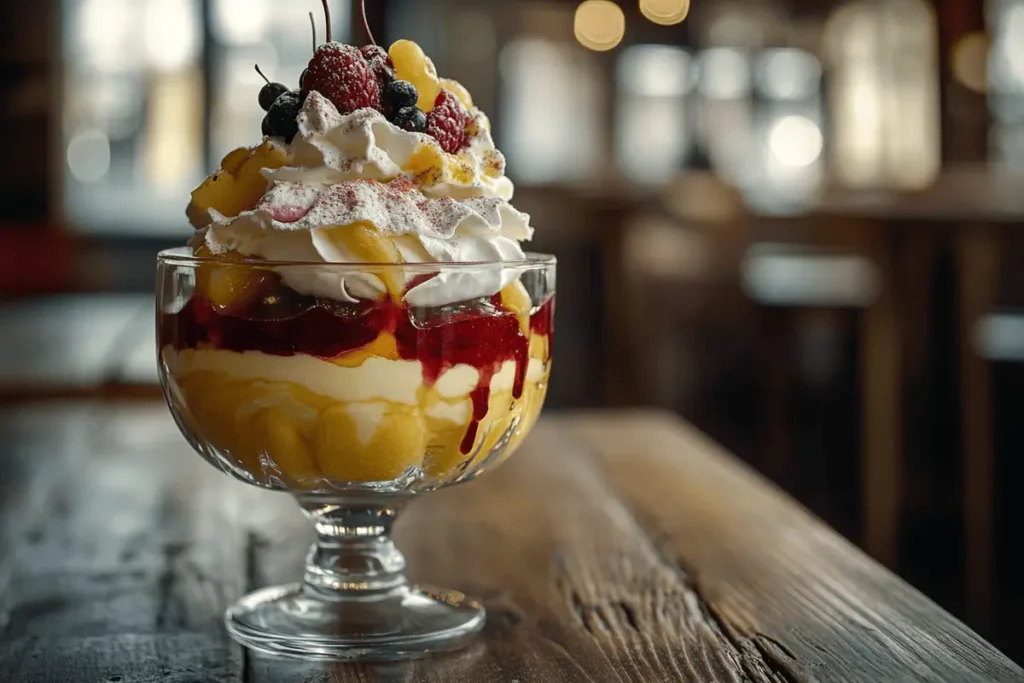Introduction
When it comes to decadent desserts, both crème brûlée and custard hold a special place in the hearts of dessert lovers. These creamy, rich creations are often confused due to their shared ingredients and similar preparation methods. But there’s more than meets the eye (and taste buds).
In this article, we’ll delve into the delicious world of crème brûlée and custard, exploring their origins, defining features, and unique characteristics. By the end, you’ll understand what sets these two iconic desserts apart, how they overlap, and when to pick one over the other. Let’s dig in!
Introduction to Crème Brûlée and Custard
What Are Crème Brûlée and Custard?
Crème brûlée and custard are both classic, egg-based desserts that have been delighting palates for centuries. While custard serves as the base for countless recipes, including pies, puddings, and tarts, crème brûlée is celebrated for its luxurious caramelized sugar topping and velvety texture. Both desserts start with similar ingredients—cream, eggs, sugar, and flavorings—yet differ significantly in execution and final presentation.
Why Compare Crème Brûlée and Custard?
Understanding the difference between crème brûlée and custard goes beyond simple curiosity. If you’re a dessert enthusiast, knowing how they vary can elevate your culinary skills and sharpen your ability to select the perfect dessert for any occasion. This comparison also reveals how slight changes in technique and ingredients can create entirely distinct flavor experiences.
Historical Context and Origins
Custard’s history dates back to ancient Rome, where cooks combined milk and eggs to create simple, satisfying dishes. Over time, custard evolved into various forms, from pastry fillings to baked puddings. Crème brûlée, on the other hand, emerged in 17th-century France, quickly gaining fame for its dramatic caramelized sugar crust—a feature that distinguishes it from its cousin, custard.
These origins highlight the unique journeys of both desserts and set the stage for understanding their nuanced differences. While custard embodies versatility, crème brûlée exudes elegance and indulgence.
Defining Crème Brûlée
What Is Crème Brûlée?
Crème brûlée is a quintessential French dessert that translates to “burnt cream.” It’s loved for its rich, creamy interior and its signature caramelized sugar topping, which creates a satisfying crunch with every bite. Unlike many other custard-based desserts, crème brûlée focuses on a dramatic contrast between textures—a silky custard beneath a hard, golden crust.
Key Ingredients in Crème Brûlée
The basic ingredients in crème brûlée include heavy cream, egg yolks, sugar, and vanilla. Each element plays a vital role: the cream adds richness, the egg yolks provide structure, and the sugar brings sweetness and, eventually, that iconic caramelized layer. Variations sometimes incorporate other flavors, such as chocolate or citrus.
For an in-depth guide to making this dessert flawless, check out this recipe detailing the secret to crème brûlée.
How Crème Brûlée Is Made
The process begins by gently heating cream and infusing it with vanilla or other flavors. Next, egg yolks and sugar are whisked together until light and creamy. The warm cream is gradually added to the egg mixture before the custard is baked in a water bath to ensure even cooking. Finally, just before serving, sugar is sprinkled on top and caramelized using a kitchen torch or broiler.
Unique Features of Crème Brûlée
What sets crème brûlée apart is its signature topping. That caramelized sugar crust is achieved by applying intense heat to the sugar layer, creating a crunchy shell. This process is what gives crème brûlée its distinctive look and taste. Its presentation in individual ramekins further emphasizes its elegant, gourmet appeal.
Defining Custard
What Is Custard?
Custard is a versatile dessert base that consists of a mixture of milk or cream, eggs, and sugar. It serves as the foundation for countless sweet treats, ranging from pies and puddings to ice creams and flans. Unlike crème brûlée, custard comes in various consistencies, from a thick, sliceable texture to a runnier, sauce-like form.
Types of Custard: Baked, Stirred, and Set
There are three primary types of custard:
- Baked Custard: Firm and creamy, baked custard is cooked in the oven, often in a water bath, just like crème brûlée. Examples include flan and cheesecake.
- Stirred Custard: Made on the stovetop, this version is silky and often used as a base for desserts like ice cream.
- Set Custard: Thickened with starch or gelatin, set custard is used in layered desserts or as fillings for tarts.
Core Ingredients in Custard
Custard relies on eggs for structure and milk or cream for its smooth texture. Sugar is added for sweetness, while additional flavors like vanilla, nutmeg, or even savory spices can be included for variety. Starch, such as cornstarch, is often used in set custards to provide extra stability.
How Custard Is Prepared
The preparation of custard varies depending on its type. For baked custard, the mixture is poured into a dish and cooked slowly in a water bath. Stirred custards are cooked gently on the stovetop, requiring constant stirring to avoid curdling. Set custards, meanwhile, are thickened with a combination of heat and added stabilizers.
For creative custard recipes and tips, visit this resource for custard-based desserts.
Key Differences Between Crème Brûlée and Custard
Texture: Silky vs. Firm
One of the most noticeable differences between crème brûlée and custard lies in their texture. Crème brûlée boasts a silky, creamy interior that melts in your mouth, complemented by a hard, caramelized sugar crust. Custard, on the other hand, varies depending on its type—it can be creamy, firm, or even sauce-like. For baked custard, the texture is often firmer, making it sliceable and ideal for pies and tarts.

Flavor Profiles and Additives
What’s the difference between crème brûlée and custard in terms of flavor? Crème brûlée tends to have a more luxurious, indulgent taste due to its high cream content and caramelized sugar topping. Custard, however, is more versatile and can feature a broader range of flavors, from vanilla and chocolate to nutmeg or even savory elements. This adaptability makes custard a popular choice in both sweet and savory dishes.
Presentation and Appearance
The way these desserts are served also sets them apart. Crème brûlée is typically presented in individual ramekins with a glossy, caramelized crust, making it a showstopper at fancy dinners. Custard, meanwhile, is often poured into pies, layered in desserts, or served as a sauce. Its appearance depends largely on its preparation method and intended use.
Cooking Techniques
Both desserts involve careful cooking techniques, but the methods differ slightly. Crème brûlée requires precise caramelization of the sugar topping, usually with a kitchen torch or broiler. Custard preparation can vary widely—baking, stirring, or thickening with starch. These techniques highlight the unique characteristics of each dessert and offer opportunities for experimentation.
For tips on creating the perfect crème brûlée crust, explore this guide to caramelizing crème brûlée toppings.
Similarities Between Crème Brûlée and Custard
Shared Ingredients
Both crème brûlée and custard share a core set of ingredients: eggs, sugar, milk, or cream. These foundational components give both desserts their signature richness and smooth texture. Whether baked or stirred, these ingredients play a vital role in creating the creamy base that dessert lovers adore.
Overlapping Preparation Techniques
While their cooking methods differ slightly, both desserts involve careful attention to temperature and timing. Both crème brûlée and custard are often cooked in a water bath, a technique that ensures gentle, even heat to prevent curdling. This method showcases the culinary precision required to master these iconic dishes.
Cultural Overlaps
Despite their unique characteristics, both desserts have carved out a special place in global cuisine. Custard serves as the backbone for countless regional desserts, from British trifles to Italian panna cotta. Similarly, crème brûlée has become a symbol of French fine dining, yet its appeal has spread far beyond France.
For a deeper dive into custard variations, consider checking out other recipes on MultyRecipes.

When to Choose Crème Brûlée vs. Custard
Occasions for Crème Brûlée
If you’re planning a dinner party or a special event, crème brûlée is often the perfect choice. Its dramatic presentation, with the caramelized sugar crust, always wows guests. This dessert is ideal for celebrations or occasions where you want to add a touch of elegance to the menu. Plus, the act of cracking through the hardened top adds a layer of fun and interaction that most other desserts can’t match.
When Custard Works Best
Custard is a more versatile dessert that fits into both casual and formal settings. Whether served as a simple pudding, layered in trifles, or used as a pie filling, custard’s adaptability makes it a reliable choice. It’s especially handy when you need a base for other desserts or a sauce to complement cakes and pastries.
Personal Preferences and Dietary Considerations
When deciding between the two, personal taste and dietary needs often come into play. For those who prefer lighter, more subtle flavors, custard offers flexibility in sweetness and texture. Meanwhile, crème brûlée appeals to those seeking a rich, indulgent treat with a crunchy finish. Understanding the difference between crème brûlée and custard helps you pick the right dessert for every palate.
Frequently Asked Questions (FAQs)
What Makes Crème Brûlée Different from Custard?
The most striking feature of crème brûlée is its caramelized sugar topping, which sets it apart from traditional custard. While custard can be baked, stirred, or set, crème brûlée always includes a firm custard base with a signature crunchy crust.
Is Crème Brûlée a Type of Custard?
Yes, crème brûlée is technically a type of custard due to its egg-and-cream base. However, its preparation and finishing touches make it a unique dessert with a distinct identity.
Can You Substitute Custard for Crème Brûlée?
While custard can mimic some aspects of crème brûlée, it lacks the iconic caramelized top. If you’re short on time or tools, custard may work as a substitute in terms of flavor, but it won’t provide the same experience.
Why Does Crème Brûlée Have a Caramelized Top?
The caramelized sugar topping on crème brûlée adds texture and depth of flavor, elevating it from a simple custard to a gourmet treat. It’s achieved by sprinkling sugar over the custard and using a kitchen torch or broiler to create a golden, crunchy layer.
Popular Misconceptions About Crème Brûlée and Custard
Are Crème Brûlée and Custard the Same?
A common misconception is that crème brûlée and custard are interchangeable. While it’s true that crème brûlée is technically a custard, the differences in preparation and presentation make them unique. Custard can be stirred, baked, or set, while crème brûlée is always baked and topped with a caramelized sugar crust. Understanding what’s the difference between crème brûlée and custard helps clarify why they’re distinct.
Do They Use the Same Ingredients?
Another myth is that both desserts rely on identical ingredients. While they share key components like cream, eggs, and sugar, the proportion of cream to milk and the use of specific flavors like vanilla or citrus set them apart. Additionally, crème brûlée’s preparation demands extra steps, such as torching the sugar, which creates its standout feature.
Is One Always Better Than the Other?
Some people assume crème brûlée is inherently more sophisticated than custard, but this depends on personal preferences and context. Custard’s versatility makes it a go-to option for many dishes, while crème brûlée is a showstopper suited for special occasions. Recognizing the distinct strengths of each dessert avoids unfair comparisons.
Final Thoughts on Crème Brûlée and Custard
As we’ve explored throughout this article, what’s the difference between crème brûlée and custard lies in their textures, flavors, and preparation techniques. While crème brûlée dazzles with its caramelized sugar topping and creamy interior, custard’s versatility allows it to shine in countless desserts.
Whether you’re indulging in a decadent crème brûlée or savoring the comforting simplicity of custard, both desserts bring their own charm to the table. Understanding these distinctions not only enhances your appreciation for each dessert but also empowers you to choose the perfect treat for any occasion.
In the end, the choice between crème brûlée and custard boils down to personal taste, presentation needs, and the effort you’re willing to invest. Both are classic desserts with rich histories, and each deserves a place in your repertoire.
For more inspiration and recipes, check out related articles on MultyRecipes. From tips for perfecting caramelization to creative custard-based dishes, you’ll find ideas to delight your taste buds and elevate your skills in the kitchen.

